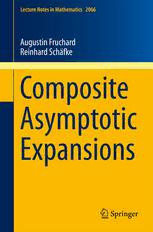
Composite Asymptotic Expansions PDF
Preview Composite Asymptotic Expansions
Lecture Notes in Mathematics 2066 Editors: J.-M.Morel,Cachan B.Teissier,Paris Forfurthervolumes: http://www.springer.com/series/304 • Augustin Fruchard Reinhard Scha¨fke (cid:2) Composite Asymptotic Expansions 123 AugustinFruchard ReinhardScha¨fke LaboratoiredeMathe´matiques, InstitutdeRechercheMathe´matique InformatiqueetApplications Avance´e Universite´deHauteAlsace Universite´deStrasbourg Mulhouse Strasbourg France France ISBN978-3-642-34034-5 ISBN978-3-642-34035-2(eBook) DOI10.1007/978-3-642-34035-2 SpringerHeidelbergNewYorkDordrechtLondon LectureNotesinMathematicsISSNprintedition:0075-8434 ISSNelectronicedition:1617-9692 LibraryofCongressControlNumber:2012953999 MathematicsSubjectClassification(2010):41A60,34E,34M30,34M60 (cid:2)c Springer-VerlagBerlinHeidelberg2013 Thisworkissubjecttocopyright.AllrightsarereservedbythePublisher,whetherthewholeorpartof thematerialisconcerned,specificallytherightsoftranslation,reprinting,reuseofillustrations,recitation, broadcasting,reproductiononmicrofilmsorinanyotherphysicalway,andtransmissionorinformation storageandretrieval,electronicadaptation,computersoftware,orbysimilarordissimilarmethodology nowknownorhereafterdeveloped.Exemptedfromthislegalreservationarebriefexcerptsinconnection with reviews or scholarly analysis or material supplied specifically for the purpose of being entered and executed on a computer system, for exclusive use by the purchaser of the work. Duplication of this publication or parts thereof is permitted only under the provisions of the Copyright Law of the Publisher’slocation,initscurrentversion,andpermissionforusemustalwaysbeobtainedfromSpringer. PermissionsforusemaybeobtainedthroughRightsLinkattheCopyrightClearanceCenter.Violations areliabletoprosecutionundertherespectiveCopyrightLaw. Theuseofgeneraldescriptivenames,registerednames,trademarks,servicemarks,etc.inthispublication doesnotimply,evenintheabsenceofaspecificstatement,thatsuchnamesareexemptfromtherelevant protectivelawsandregulationsandthereforefreeforgeneraluse. While the advice and information in this book are believed to be true and accurate at the date of publication,neithertheauthorsnortheeditorsnorthepublishercanacceptanylegalresponsibilityfor anyerrorsoromissionsthatmaybemade.Thepublishermakesnowarranty,expressorimplied,with respecttothematerialcontainedherein. Printedonacid-freepaper SpringerispartofSpringerScience+BusinessMedia(www.springer.com) Preface The purpose of this memoir is to present a theory of asymptotic expansions for functions of two variables, using at the same time functions of one variable and functionsofthequotientofthesetwovariables.Thesecompositeasymptoticexpan- sions(CAsEs for short) are particularly well suited to the description of solutions of singularly perturbed ordinary differential equations. Their use is classical for boundarylayers,butlessfamiliarnearturningpoints. Letusdescribethecontextinafewwords.Consideranequationoftheform dy " D˚.x;y;"/ (1) dx where˚ isinfinitelydifferentiable,xandyarerealorcomplexvariables,and"isa smallparameter,realpositiveorinasectorofthecomplexplane.Suchanequation mightbeobtainedfromanautonomousslow–fastsystem du D"f.u;v;"/ dt (2) dv Dg.u;v;"/ dt byeliminationofthevariablet,i.e.byconsideringthefunctiony Dvıu(cid:3)1. Theslowsetof(1)isthesubsetL ofC2determinedby˚.x;y;0/D0.Apoint .x;y/ of L is called regularif @˚.x;y;0/ ¤ 0; otherwise it is called a turning @y point. Ina neighborhoodofa regPularpoint.ex;ey/ 2 L,oneeasilyseesthat(1)hasa unique formal solutionby D y .x/"n and it is known that certain solutions n(cid:4)0 n of(1)haveby asasymptoticexpansioninappropriatedomains.Theclassicaltheory ofcompositeexpansions(seee.g.Vasi’leva/Butuzov[59]) isusefultodescribethe boundarylayer (also called inner layer) of a solution which takes atex an initial valuecloseenoughtoey.Forexample,intherealframework,ifthe point.ex;ey/is v vi Preface attracting,i.e. @˚.ex;ey;0/ < 0,thenanapproximationofthesolutiony D y.x;"/ @y P (cid:2) can be given, uniformlyon some intervalŒex;ex Cı(cid:2), of the form y .x/C (cid:3) (cid:4)(cid:5) n(cid:4)0 n z x(cid:3)ex "n,containingtheformalsolutionby aswellasfunctionsz exponentially n " n decreasingatinfinity.SeealsoBenoˆıt/ElHamidi/Fruchard[4] fordetails. Ataturningpoint.x(cid:5);y(cid:5)/,thecoefficientsoftheformalsolutionmayhavepoles orramifiedsingularitiesandtheclassicaltheoryofcompositeexpansionsnolonger applies. The most commonmethodto obtain an approximationof the solutionsis thematchingoftheso-calledinnerandouterexpansions;inourmemoirwewould liketoproposeanalternative. WepresentanextensivestudyofinfiniteCAsEsoftheform X(cid:2) (cid:3) (cid:4)(cid:5) a .x/Cg x(cid:3)x(cid:2) (cid:3)n; (3) n n (cid:3) n(cid:4)0 (cid:3) a certain rootof ", thatare uniformlyvalid for x in some sector with vertexx(cid:5) satisfying Kj(cid:3)j (cid:3) jx(cid:4)x(cid:5)j (cid:3) L with some K;L > 0, and sometimes even in a full neighborhood(cid:2)of x(cid:5)(cid:5)of size O.j(cid:3)j/. Such CAsEs provide outer expansions by re-expanding g x(cid:3)x(cid:2) with respect to (cid:3) and inner expansions by replacing n (cid:3) x D (cid:3)X andre-expandinga .(cid:3)X/.Oneadvantageofcompositeexpansionsisthat n theyprovideapproximationsalsoin“intermediate”rangesKj(cid:3)j˛ (cid:3) jxj (cid:3) Lj(cid:3)jˇ, where0<ˇ (cid:3)˛ <1. Composite expansions and even more composite approximations are not new. In the context of matched asymptotic expansions, they are often found as the sum of inner and outer expansions, less the terms common to both see e.g. Kevorkian/Cole[35],p.13,orSkinner[54],p.4.We proposetoworkdirectlywith composite expansions using the many properties and theorems we present and comparewithinnerandouterexpansionsinasecondstep.Moreremarksconcerning therelationswithpreviousworkwillbegiveninChap.7. There is a vast literature on singular perturbation methods for ordinary differ- ential equations. The presentation of another book on this subject should be well motivated. We hope to shed some new light on composite expansions with the followingfeatures. (cid:129) Weworkwith infiniteasymptoticexpansions,discusstheiralgebraicandanalytic properties,andusethemtoobtainnewresults. (cid:129) The expansions are mainly presented in the complex domain. Their regions of validityaremodifiedsectorswithvertexataturningpoint. (cid:129) We also present a Gevrey theory of CAsEs—so far the Gevrey theory was confined to classical uniform asymptotic expansions where the coefficients depend upon one or more variables different from the expansion variable. In the literature on singularly perturbed ordinary differential equations the Gevrey theory was mainly used in full neighborhoods of a turning point Preface vii (e.g.Canalis-Durand/Ramis/Scha¨fke/Sibuya[9]) whereasherewe have(quasi-) sectorswithvertexataturningpoint. (cid:129) We exhibitthreeapplications,in two ofwhichnewresultsare obtained,thanks totheGevreytheoryofCAsEs. The plan of the memoir is as follows. In the first chapter, we present simple examples of linear differential equations to convince the reader that composite asymptoticexpansionsarenatural,evenunavoidable,nearturningpoints. ThesecondchapterpresentsthedefinitionofCAsEsandtheircompatibilitywith algebraic and analytic operations and discusses the relation with the method of matched asymptotic expansions.The third chapter containsthe Gevreyversion of the theory of CAsEs. The relation with exponentially small terms is an important feature. Chapter 4 states and proves our most important theorem on the existence of Gevrey CAsEs. It essentially states, for a family of holomorphic functions of .x;(cid:3)/ that are bounded on a so-called consistent good covering of a punctured neighborhood of .0;0/, that each of them has a Gevrey CAsE provided their differencesareexponentiallysmall.Weemphasizethathere,unlikeintheclassical Gevrey theory(cid:2), two kinds(cid:5)of exponential smallness appear: the differences in the x-planeareO e(cid:3)cjxjp=j(cid:3)jp andhenceonlysmallawayfromtheoriginwhereasthe (cid:2) (cid:5) differencesinthe(cid:3)-planeareO e(cid:3)c=j(cid:3)jp asusual. Chapter5appliesthetheoryofCAsEstosingularlyperturbednonlinearordinary differential equations of first-order near turning points. We present two methods for obtaining CAsEs. The first is direct, followingthe classical lines: study formal solutionsoftheform(3),thenprovetheexistenceofananalyticsolutionhavingthis formalsolutionasa CAsE. Thesecondmethodismoreindirectandusesthe main result of Chap. 4, embedding a single solution in a family of solutions on a good coveringofaneighborhoodoftheturningpointandshowingthattheirdifferences satisfy exponential estimates. A reader familiar with differential equations in the realdomainmightfindthismethodtoo“complex,”butitis,toourknowledge,the simplestoneinthecontextofsingularperturbation. Wefirsttreatatypeofequationsallowinganalyticcontinuationofthesolutionsto asmallneighborhoodoftheturningpointandthenconsidermoregeneralequations. ThemostpowerfulresultinthissectionisTheorem5.17. Inthesixthchapter,weapplythepreviousresultsandusethegeneralproperties of CAsEs for severalwell-known problemsof singular perturbation:canards solu- tions near multiple turning points, non-smoothcanards, and Ackerberg–O’Malley resonance. The linear differential equation of second order appearing in the third problemisreducedtoafirst-orderRiccatiequationtowhichourresultsareapplied. Forthefirstandthirdproblems,weobtainnewresults,andforthesecondproblem, wecanaddGevreypropertiesandGevreyCAsEstotheknownresults. Thememoirfocusesonordinarydifferentialequationsandonlyconsidersfirst- ordernonlinearandsecond-orderlinearequations,butweareconvincedthatCAsEs viii Preface can be very useful for equationsof higher order and for other types of functional equations,especiallydifferenceequations. Wehaveincludedafewexercisesforthebenefitofthereader—inmostofthem, theresultsofthecorrespondingsectionareappliedtoexamples. Acknowledgements TheworkofthesecondauthorwassupportedinpartbygrantsoftheFrench NationalResearchAgency(ref.ANR-10-BLAN0102andANR-11-BS01-0009). Contents 1 FourIntroductoryExamples ............................................... 1 1.1 FirstExample ........................................................... 1 1.2 Extensions............................................................... 6 1.3 SecondExample ........................................................ 9 1.4 ThirdExample .......................................................... 11 1.5 FourthExample ......................................................... 13 1.6 CompositeExpansions.................................................. 14 2 CompositeAsymptoticExpansions:GeneralStudy ..................... 17 2.1 Notation ................................................................. 17 2.2 CompositeFormalSeries............................................... 19 2.3 CompositeExpansions:DefinitionandBasicProperties ............. 22 2.4 CompositeExpansionsandMatching.................................. 29 2.5 ContinuationofCompositeExpansions ............................... 34 2.6 QuotientsofCAsEs...................................................... 37 2.7 MultipleCAsEs.......................................................... 40 3 CompositeAsymptoticExpansions:GevreyTheory..................... 43 3.1 CompositeGevreyFormalSeries ...................................... 43 3.2 CompositeGevreyAsymptoticExpansions ........................... 47 3.3 FlatGevreyFunctions .................................................. 53 3.4 TheoremsofBorel–RittType .......................................... 55 3.5 ConsistentGoodCoverings............................................. 59 4 ATheoremofRamis–SibuyaType......................................... 63 4.1 StatementoftheTheoremandBeginningoftheProof ............... 63 4.2 TheSlowPart ........................................................... 67 4.3 TheFastPart ............................................................ 70 4.4 StudyoftheFunctionsgj .............................................. 71 n 4.5 TheCase(cid:4)Negative.................................................... 74 4.6 CompositionofaGevreyCAsEandanAnalyticFunction............ 76 ix x Contents 5 Composite Expansions and Singularly Perturbed DifferentialEquations....................................................... 81 5.1 ClassicalCAsEsataRegularPoint..................................... 82 5.2 CAsEsataTurningPoint:TheQuasi-linearCase ..................... 89 5.2.1 CompositeFormalSolutions................................... 90 5.2.2 AnalyticSolutionsandCAsEs.................................. 93 5.2.3 TheGevreyCharacterofCAsEs................................ 99 5.2.4 RemarksandExtensions ....................................... 103 5.3 CAsEataTurningPoint:AGeneralization............................ 106 6 Applications .................................................................. 119 6.1 CanardsinaMultipleTurningPoint................................... 120 6.2 Non-smoothCanards.................................................... 126 6.2.1 Equationsof“UnionJack”Type............................... 126 6.2.2 Non-smoothEquations......................................... 132 6.3 Ackerberg–O’MalleyResonance....................................... 136 7 HistoricalRemarks .......................................................... 151 References......................................................................... 155 Index............................................................................... 159
